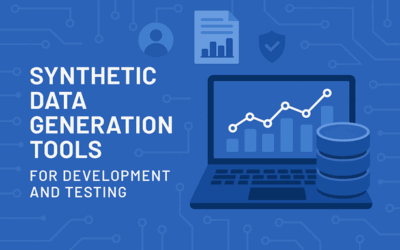
What Is Big Data Security and How to Implement It
12
APRIL, 2022
by Rhuan Souza
Introduction to What Is Big Data Security and How to Implement It
In today’s world, information has become an important resource that companies can rely on to make decisions and to get to know the market and its customers. And the amount of information, as well as the frequency at which it’s available, continues to grow. This is what’s known as big data.
Data is no longer just a part of an application; it’s a valuable resource, and when this resource becomes more and more valuable, we also have to increase the methods and processes we have to prevent malicious attacks, data breaches, or sensitive data exposure.
With the advent of web applications and the quick growth in the amount of data traffic between networks, it’s become increasingly important to consider security as one of the key factors in order to provide a safe environment not just for users but also for developers. There’s no such thing as invulnerable information systems; however, there is a series of good practices or even tools that we can use to make software as safe as it can be. And this is where big data security comes in.
So knowing what big data security means and how to implement it is crucial to keeping businesses and data safe. That’s what we’ll cover in this post.
But first, let’s define big data a little more in depth.
What Is Big Data?
According to Oracle, the definition of big data is “data that contains greater variety, arriving in increasing volumes and with more velocity.”
So where does so much data come from? Basically, it comes in automated forms from IoT devices, security cameras, machine data, and all sorts of data we generate ourselves—like posts on social networks, reviews about somewhere you have been, GPS data, searches on a search engine, and any other kind of data and source you can imagine.
Use Cases of Big Data
All this data can be used in various ways. After being analyzed, this data can be transformed into useful information and be used as a tool to guide decisions for many companies.
Here are some potential use cases:
- Health care: Various prediction algorithms can be deployed based on a large amount of information available in the health care arena. It’s possible to compare different information such as air pollution data, symptoms of a certain disease recorded in a medical appointment, and even posts made on social networks of people saying they have a certain disease. All this information can be correlated in order to reach conclusions such as in which specific region disease is more present. This is how the Google Trends tool acted when the world suffered from the outbreak of the H1N1 epidemic.
- Public security: In 2013, during a marathon in the city of Boston, a terrorist attack caused the death of three people and injured 264 others. The local police deployed a big data system, which collected information made available by third parties. This included various footage that took place during the marathon by personal cell phone or security cameras, analysis of the behavior of individuals, and, above all, who was carrying backpacks during the marathon. Through a case study and correlation of various data, the police managed to identify and arrest the terrorist.
- Product development: Companies can use big data to understand the customers’ behavior and recommend custom content according to their preferences.
- Autonomous vehicles: Vehicles can use data collected by a large number of sources such as sensors, GPS, and IoT devices. In this particular use case, big data plays a critical role.
These are just some use cases, but there are a ton of other cases where we use big data.
Importance of Data Security in Organizations
Data or information security refers to all actions taken to preserve the information that users share on the internet. The objective is to protect data against theft, unauthorized modification, and malicious access by third parties.
Every organization deals with volumes of data from various sources, such as financial flows, employees, or customers. Therefore, mismanagement of this information can result in great losses. Exactly for this reason, it’s necessary to think about data security.
The organization’s loss of control over protected or sensitive data is a serious and often reported business impact. The adoption of data encryption can provide mitigation against the compromise of data. Also, this is a regulatory requirement for most controlled data.
Why Security Is Important When We Talk About Data
Because of the need to obtain essential data and information for organizations, it’s crucial to implement information security procedures in order to prevent risks.
Currently, malicious actions aimed at the invasion of business systems, breach of data confidentiality, and cyberattacks are on the rise. Hacking actions are always harmful for the company’s image as well as the damage caused and the data disclosed.
Because of this potential damage, organizations that don’t implement the necessary measures to protect themselves are certainly putting their activities at risk and harming the security of customer data.
Information security is important because it protects all categories of data from theft and damage. This includes confidential data, personally identifiable information, health information, intellectual property, and data and information systems, both corporate and government.
Ways to Implement Big Data Security
Setting an Information Security Policy
Before investing in infrastructure, a company needs to prepare its internal culture for information security. At this point, for example, it’s essential to create and implement a policy that reinforces this idea.
High investments in equipment, software, and security solutions are useless if the organization’s human resources are still not aligned. Thus, the first step is to raise awareness, educate, train, and prepare the environment for a security mindset.
Implementing IT Risk Management
It’s important to support information security with prevention strategies. Anticipating risks and managing them in the least harmful way possible is also crucial.
For this reason, the company has to work with IT risk management. In risk management, professionals need to actively be identifying points of concern that can lead to breaches in security.
Another information security procedure that every company needs to adopt is encryption tools for passwords. This is perhaps the most basic measure to protect access to systems, especially when communication takes place over the internet. Encryption is a security feature that prevents the contents of passwords from being accessed by malicious software, hackers, etc. The technology uses its own keys to scramble the characters, making it almost impossible to read the information.
Going Beyond an Information Security Investment Strategy
Defining an information security investment strategy, based on the results of security investments for the security of the business, is important. But just implementing the security strategy and providing the appropriate investment simply isn’t enough for those responsible for the information security strategy.
Rather, it’s better to integrate information security into the organization’s processes in order to have an investment strategy based on business objectives.
The company’s top management has to ensure this.
Setting Up Firewall Configuration
In times of digital journeys, the use of the network for business communications and operations is massive. Therefore, the risks in these activities are also greater. However, one of the ways to protect company information is through firewalls.
In practice, firewall technology is what qualifies data communication between companies and external sources. It works by filtering the data stream, allowing only authorized access to specific ports. Currently, most operating systems already include firewalls.
However, when it comes to companies, where data is the most valuable asset, it’s necessary to adopt even more robust systems and more sensitive configurations, which require specialized support from IT professionals.
Conclusion
More and more, the number of companies that use big data to build business strategies is increasing. There are still a lot of challenges for big data security, and new tools and government regulations are emerging.
As technology is very dynamic, we can expect huge changes over the years. We’ll have to deal with new challenges, but luckily we’ll manage to build new tools to deal with them.
Post Author
This post was written by Alexander Fridman. Alexander is a veteran in the software industry with over 11 years of experience. He worked his way up the corporate ladder and has held the positions of Senior Software Developer, Team Leader, Software Architect, and CTO. Alexander is experienced in frontend development and DevOps, but he specializes in backend development.
Relevant Articles
7 Synthetic Data Generation Tools for Dev & Testing
In software development and testing, having access to high-quality, realistic data is crucial. But real production data is often sensitive, regulated, or simply unavailable for testing purposes. Synthetic data generation tools provide a powerful alternative, enabling...
The SAFe Hierarchy and Levels, Explained in Depth
The Scaled Agile Framework (SAFe) is a comprehensive set of principles and practices designed to help organizations adopt agile methods on an enterprise level. It provides a set of guidelines and best practices that enable large-scale product development with agility....
DORA Compliance – Why Data Resilience is the New Digital Battlefield
How Enov8 Helps Financial Institutions Align with the EU's Digital Operational Resilience Act Executive Introduction As of January 2025, the EU's Digital Operational Resilience Act (DORA) has become legally binding for financial institutions operating across the...
Data Fabric vs Data Mesh: Understanding the Differences
When evaluating modern data architecture strategies, two terms often come up: data fabric and data mesh. Both promise to help enterprises manage complex data environments more effectively, but they approach the problem in fundamentally different ways. So what’s...
What Is Release Management in ITIL? Guide and Best Practices
Managing enterprise software production at scale is no easy task. This is especially true in today’s complex and distributed environment where teams are spread out across multiple geographical areas. To maintain control over so many moving parts, IT leaders need to...
Test Environment: What It Is and Why You Need It
Software development is a complex process that requires meticulous attention to detail to ensure that the final product is reliable and of high quality. One of the most critical aspects of this process is testing, and having a dedicated test environment is essential...










